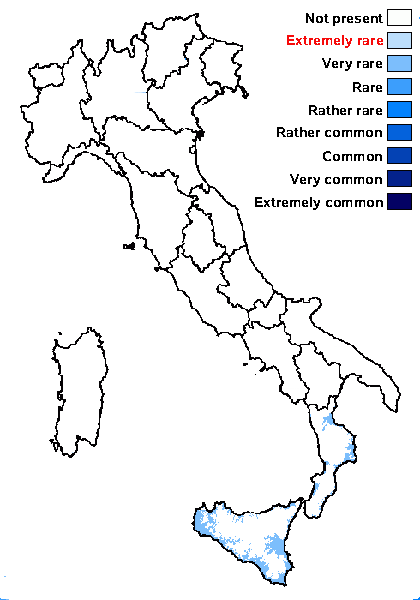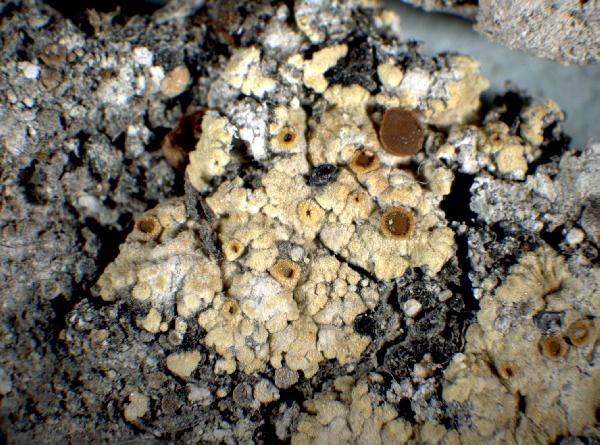Gyalolechia poeltii (Llimona) ined.
provisionally placed here, ICN Art. 36.1b. Basionym: Fulgensia poeltii Llimona - Opusc. Sparsa (Bot. Dep. Fac. Sci., Univ. Barcinon.), 6: 10, 1974
Synonyms:
Distribution: S - Cal (Nimis & Martellos 2004), Si (Grillo & Caniglia 2005).
Description: Thallus crustose, episubstratic, orange-yellow, of flattened, contiguous areoles forming a more or less compact crust, the central ones often with granulose schizidia, the marginal ones sometimes slightly elongate, but never forming a placodioid thallus. Apothecia frequent, zeorine, sessile, 1-2 mm across, with an orange-brown, weakly concave to flat, smooth to rugose disc, and a thick, orange-yellow margin, which at maturity separates into a darker and thinner proper margin and a paler, fineally excluded thalline margin. Excipular hyphae with oblong lumina, weakly to moderately gelatinized; epithecium brownish orange, K+ red; hymenium and hypothecium colourless. Asci 8-spored, clavate, functionally unitunicate, apically thickened with a broad internal beak, the inner part of apex and external cap I+ blue, Teloschistes-type. Ascospores 1-celled, hyaline, subcylindrical but more or less constricted in the centre, thin-walled, 12-16 x 3-5 µm. Pycnidia orange-yellow, immersed. Conidia oblong- ellipsoid. Photobiont chlorococcoid. Spot tests: thallus and apothecia K+ dark red, C-, KC-, P-, UV+ pale orange. Chemistry: not known, but probably similar to that of other related species, with fragilin dominant, and smaller amounts of emodin and parietin.
Note: a Mediterranean lichen found on calciferous or gypsiferous soil in dry, open situations, probably more widespread in Southern Italy, especially in areas with a warm-dry climate, but certainly not common.
Growth form: Crustose
Substrata: soil, terricolous mosses, and plant debris
Photobiont: green algae other than Trentepohlia
Reproductive strategy: mainly sexual
Commonnes-rarity: (info)
Alpine belt: absent
Subalpine belt: absent
Oromediterranean belt: absent
Montane belt: absent
Submediterranean belt: absent
Padanian area: absent
Humid submediterranean belt: absent
Humid mediterranean belt: very rare
Dry mediterranean belt: very rare

Predictive model
Growth form: Crustose
Substrata: soil, terricolous mosses, and plant debris
Photobiont: green algae other than Trentepohlia
Reproductive strategy: mainly sexual
Commonnes-rarity: (info)
Alpine belt: absent
Subalpine belt: absent
Oromediterranean belt: absent
Montane belt: absent
Submediterranean belt: absent
Padanian area: absent
Humid submediterranean belt: absent
Humid mediterranean belt: very rare
Dry mediterranean belt: very rare

Predictive model



